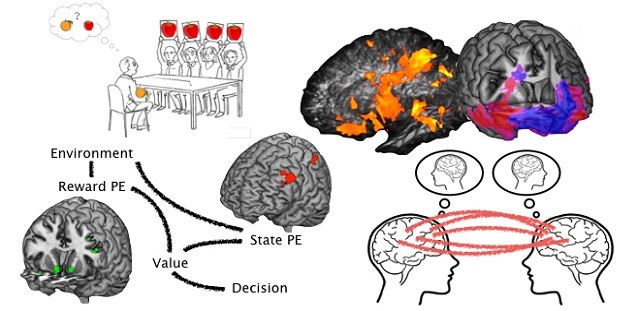Overview
Every day in our lives is plastered with decisions, from the minute (What shall I have for breakfast?) to the grand (Shall I pursue a career in decision neuroscience?). Common theoretical accounts posit that the human brain accomplishes decision making through a series of neural computations, in which the expected future reward of different decision options are compared with one another and then the option with the highest expected value is usually selected. Thus, valuation lies at the heart of the puzzle of human decision making.
Our group is interested in tracking down these values signals in the brain and the representations of choice options using computational modeling of choice behavior in combination with fMRI and EEG. This approach, called model-based fMRI. allows us to identify neural structures that participate in the computation of expected values and their updating through learning. In general, we try to understand valuation by perturbing this process through experimental manipulation, record the change in valuation, and therefore learn how the brain organizes value computations.
We are primarily focussed on social decision-making to understand how social reasoning and Theory of Mind changes the own valuation process by internally simulating the decisions of others. We have developed a novel experimental protocol task in the decision-making domain that mimics the dynamics of the classic “Sally Anne Task”, one of the most commonly used test for Theory of Mind abilities. Using EEG hyperscanning (concurrent recording in two players) with this cooperative decision making task we are investigating intra- and inter-brain connectivities during social reasoning processes and Theory of Mind.
We have developed new experimental protocols to look into how social conformity with others changes the computation of expected values and how the social information form others is integrated into the own decision making process. By serializing the own decision and the decisions of others we can characterize value computations and their updates step-by-step.
One of hallmarks of social decision-making is the recursivity of social reasoning (i.e. What is your opponent going to do? vs. what does your opponent think you are going to do?). This is often referred to as Level-k reasoning. To investigate these different levels of reasoning we have we have modified the classic Matching Pennies game to induce different levels of social reasoning.
We are also investigating how learning and decision-making change the representations of stimuli and decision states in the brain. By using multivariate analysis technique (decoding, representational similarity analysis, pattern component modeling) of fMRI data, we are investigating how unisensory patterns of stimulus representations are integrated into multisensory representation and, importantly, how these higher-order representations are changed through learning. In an extension of this simple reward learning paradigm we are also using second-order conditioning to characterize the representations of a “predictor of a predictor of a reward”.
